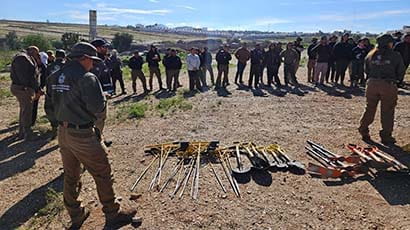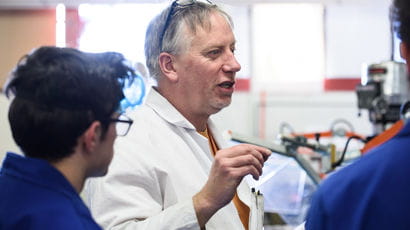Laying Pluckley’s ghosts to rest: new research uncovers the truth about the most haunted village in England

New research from the University of the West of England (UWE Bristol) has solved a series of tantalising mysteries associated with Pluckley in Kent, known for over 70 years as the ‘most haunted village in England’.
With over a dozen ghosts said to haunt the area, Dr Simon Moreton, Associate Professor of Creative Economies at UWE Bristol, set out to discover the definitive story of how the village gained its ghostly notoriety.
Who was the ‘Hanging Schoolmaster’? What really happened to the ‘Screaming Man of the Clay Pit’? Was there really a ghostly figure haunting the ruined mill? How did a local man kickstart the village’s haunted reputation in the 1950s, and what role did a mischievous BBC Radio DJ play in the whole affair?
Through extensive archival research, scouring newspapers, birth, marriage and death records, parish records and more, Simon has pieced together the origins of the village’s folklore for the first time. His peer-reviewed findings are now published in the international journal Folklore.
“I’ve been fascinated by the ghost stories of Pluckley since I was a child,” says Simon. “My late father’s ancestors came from the village, so the research has been a personal as well as a professional journey. Over the course of the research I even discovered that one of the alleged ghosts is a distant cousin – Sarah Sharp, the ‘Watercress Lady’.”
Pluckley, a small English village situated on the northern edge of the Kentish Weald between Maidstone and Ashford, was an Anglo-Saxon settlement, and boasts several historic buildings including a fourteenth-century church. It found fame in the 1990s as the setting for a popular television adaptation of H. E. Bates’s novel The Darling Buds of May and its sequels, starring David Jason and Pam Ferris.
The village also has a reputation as ‘the most haunted village in England’, rumoured to be home to anything between ten and seventeen ghosts. This accolade was first accorded to the village in 1950 and bolstered by a mention—although not an actual award—in the 1989 Guinness Book of World Records. The stories have been reported in books on ghosts since the 1960s. Ten ghost stories still appear on the village website today and popular interest in the hauntings continues in local and national news, across websites, social media, videos, television, radio programmes, and podcasts.
Simon said: “Storytelling is a fundamental human behaviour and whether or not you believe in ghosts, Pluckley’s reputation demonstrates how fascinated we are with tales with a spooky edge to them.
“What’s exciting about this research is that it’s been possible to demonstrate how one person with a passion for these kinds of story was able to shape – for better or worse – the identity of a whole village through his storytelling.”
Through his research Dr Moreton has uncovered several facts:
- Ten of Pluckley’s ghost stories were first recorded by local man Frederick Sanders (1908-1996) in self-published books on ghost hunting, letters to the local press, newspaper articles and ghost hunts. He also wrote about the ghosts in his memoir ‘Pluckley Was My Playground’ (1955, republished 2021 Canterley Publishing).
- Sanders was the first to call Pluckley ‘the most haunted village in England’ in an article for the Kentish Express in 1950. In the same article he lists ten ghosts: The Highway Man, The Watercress Woman, the Miller, the Hanging Schoolmaster, the Red Lady, the White Lady, the Colonel, the Screaming Man of the Clay Pit, the Lady of Rose Court, and the Devil’s Bush.
- Sanders did not make up the ghost stories he recorded, instead documenting them from local sources including his grandparents and his schoolteacher, Henry Turff. However, he often elaborated on stories from one source to the next and often contradicted himself.
- At least four ghost stories can be traced to real events: Sarah Sharp who burned to death in August 1911 is remembered as the ‘Watercress Woman’; Mary Ann Bennett took her own life in 1862 and is remembered as the ‘Lady of Rose Court’; Richard Bridgland died in an accident at the Pluckley Brick and Tile Works quarry in January 1899 and is remembered as the Screaming Man of the old Clay-Pit’; the ‘Hanging Schoolmaster’ was in fact a papermaker named Henry Edgar Martin who took his own life in August 1919.
- Sanders accidentally amalgamated the circumstances of Henry Edgar Martin’s death in 1919 with the biographical details of another man Harry Martin, who was a schoolmaster in nearby Smarden but died in 1923. This mistake has been perpetuated ever since.
- Three stories were fabricated by actor and DJ Desmond Carrington in an article for the 1962 TV Times Christmas Extra magazine - the phantom coach and horses, the ‘Monk of Greystones’, and a poltergeist at Surrenden Dering, the seat of the local landed gentry which burned down in 1952.
- From 1967 the village began to appear in numerous books on ghosts and received a mention—although not an actual award—in the 1989 Guinness Book of World Records. Two ghost stories were added in this era: the poltergeist at Elvey Farm, and the ghost at the Black Horse Inn.
“The way these stories get told and retold can tell us a great deal about how we use the past to understand ourselves and the places we live,” added Simon. “Local rumours take on a life of their own. Personal tragedies become salacious gossip, and sometimes social prejudices obscure the real lived experiences of the people the stories relate to. Finally, it reminds us there are real people and real places behind these stories, both of which deserve our respect.”
Dr Simon Moreton’s paper: Frederick Sanders and the Origins of the ‘Most Haunted Village in England’, 1939–79 is published in Folklore, Volume 136, 2025 - Issue 1
Related news

18 December 2025
UWE Bristol professor appointed National Institute for Health and Care Excellence CEO
Jonathan Benger CBE, Professor of Emergency Care at UWE Bristol, has been appointed as the new chief executive officer of the National Institute for Health and Care Excellence (NICE).

17 December 2025
Findings revealed from first UK study into experiences of mothers who are survivors of rape pregnancy
UWE Bristol academics have revealed the findings of the first UK-based study of the experiences of mothers who are survivors of rape pregnancy.

11 December 2025
Social media influencer work is far more demanding than it looks, research finds
A study exploring the mental health impacts of social media influencer work has revealed that life online is far more demanding than it appears.

25 November 2025
UWE Bristol experts join film Q&A exploring music and melodrama
Academics will take part in the Cary Comes Home Festival, with a post-screening Q&A exploring music, melodrama and emotional storytelling in classic cinema.

17 November 2025
Urgent reform needed to support ambulance-delivered end of life care, study finds
More than three quarters (78 per cent) of paramedics sometimes fear doing the wrong thing when caring for people in the last year of life, new research has found.

13 November 2025
Bristol’s screen industry experiences “boom-and-bust cycle” after post-pandemic recovery, new research from UWE Bristol finds
New research from UWE Bristol provides detailed insight into Bristol's screen sector.

13 November 2025
New AI research to revolutionise animal welfare
A UWE Bristol research project will combine behavioural science and AI to create technology that understands not only what animals do, but how they feel.

10 November 2025
Lessons from Low Traffic Neighbourhoods will drive better public engagement, study finds
Lessons from Low Traffic Neighbourhoods have informed a new toolkit to improve engagement with the public on challenging local street issues.

06 November 2025
First-of-its-kind study aims to help more people spend their final days at home
A new study will explore how architectural design could support end-of-life care in domestic settings.

29 October 2025
UWE Bristol academic unveils breakthrough in energy-efficient AI at NATO science forum
Dr Jonathan Lancelot has developed a new form of AI that could transform how intelligent machines operate in space, defence, and remote environments.

15 October 2025
UK food needs radical transformation on scale not seen since Second World War, new report finds
A new report from the Agri-Food for Net Zero Network+ finds urgent action on food is needed if the UK is to reboot its flagging economy, save the NHS billions, ensure national food security, and meet climate commitments.

07 October 2025
Academic playing role in project to find hidden graves in Mexico using drone technology
A UWE Bristol lecturer is playing a part in a project using drone technology to locate concealed graves in Mexico.
You may also be interested in

Media enquiries
Enquiries related to news releases and press and contacts for the media team.

Find an expert
Media contacts are invited to check out the vast range of subjects where UWE Bristol can offer up expert commentary.






